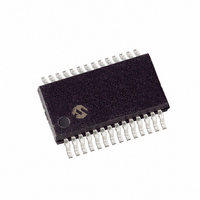PIC16C773-I/SS Microchip Technology, PIC16C773-I/SS Datasheet - Page 79

PIC16C773-I/SS
Manufacturer Part Number
PIC16C773-I/SS
Description
IC MCU OTP 4KX14 A/D PWM 28SSOP
Manufacturer
Microchip Technology
Series
PIC® 16Cr
Datasheets
1.PIC16F616T-ISL.pdf
(8 pages)
2.PIC16C773SO.pdf
(201 pages)
3.PIC16C773SO.pdf
(13 pages)
4.PIC16C773SO.pdf
(16 pages)
Specifications of PIC16C773-I/SS
Program Memory Type
OTP
Program Memory Size
7KB (4K x 14)
Package / Case
28-SSOP
Core Processor
PIC
Core Size
8-Bit
Speed
20MHz
Connectivity
I²C, SPI, UART/USART
Peripherals
Brown-out Detect/Reset, POR, PWM, WDT
Number Of I /o
22
Ram Size
256 x 8
Voltage - Supply (vcc/vdd)
4 V ~ 5.5 V
Data Converters
A/D 6x12b
Oscillator Type
External
Operating Temperature
-40°C ~ 85°C
Processor Series
PIC16C
Core
PIC
Data Bus Width
8 bit
Data Ram Size
256 B
Interface Type
I2C/SPI/SSP/UART
Maximum Clock Frequency
20 MHz
Number Of Programmable I/os
22
Number Of Timers
3
Operating Supply Voltage
2.5 V to 5.5 V
Maximum Operating Temperature
+ 85 C
Mounting Style
SMD/SMT
3rd Party Development Tools
52715-96, 52716-328, 52717-734
Development Tools By Supplier
ICE2000, DM163022
Minimum Operating Temperature
- 40 C
On-chip Adc
6-ch x 12-bit
Controller Family/series
PIC16C
No. Of I/o's
22
Ram Memory Size
256Byte
Cpu Speed
20MHz
No. Of Timers
3
Embedded Interface Type
I2C, SPI, USART
Rohs Compliant
Yes
Lead Free Status / RoHS Status
Lead free / RoHS Compliant
For Use With
309-1025 - ADAPTER 28-SSOP TO 28-DIP
Eeprom Size
-
Lead Free Status / Rohs Status
Lead free / RoHS Compliant
8.2.11
Transmission of a data byte, a 7-bit address, or either
half of a 10-bit address is accomplished by simply writ-
ing a value to SSPBUF register. This action will set the
buffer full flag (BF) and allow the baud rate generator to
begin counting and start the next transmission. Each
bit of address/data will be shifted out onto the SDA pin
after the falling edge of SCL is asserted (see data hold
time spec).
ator roll over count (T
SCL is released high (see Data setup time spec).
When the SCL pin is released high, it is held that way
for T
for that duration and some hold time after the next fall-
ing edge of SCL. After the eighth bit is shifted out (the
falling edge of the eighth clock), the BF flag is cleared
and the master releases SDA allowing the slave device
being addressed to respond with an ACK bit during the
ninth bit time, if an address match occurs or if data was
received properly. The status of ACK is read into the
AKDT on the falling edge of the ninth clock. If the mas-
ter receives an acknowledge, the acknowledge status
bit (AKSTAT) is cleared. If not, the bit is set. After the
ninth clock the SSPIF is set, and the master clock
(baud rate generator) is suspended until the next data
byte is loaded into the SSPBUF leaving SCL low and
SDA unchanged
After the write to the SSPBUF, each bit of address will
be shifted out on the falling edge of SCL until all seven
address bits and the R/W bit are completed. On the fall-
ing edge of the eighth clock the master will de-assert
the SDA pin allowing the slave to respond with an
acknowledge. On the falling edge of the ninth clock the
master will sample the SDA pin to see if the address
was recognized by a slave. The status of the ACK bit is
loaded into the AKSTAT status bit (SSPCON2<6>). Fol-
lowing the falling edge of the ninth clock transmission
of the address, the SSPIF is set, the BF flag is cleared,
and the baud rate generator is turned off until another
write to the SSPBUF takes place, holding SCL low and
allowing SDA to float.
1999 Microchip Technology Inc.
BRG
, the data on the SDA pin must remain stable
I
2
C MASTER MODE TRANSMISSION
SCL is held low for one baud rate gener-
(Figure
BRG
8-26).
). Data should be valid before
Advance Information
8.2.11.7
In transmit mode, the BF bit (SSPSTAT<0>) is set when
the CPU writes to SSPBUF and is cleared when all 8
bits are shifted out.
8.2.11.8
If the user writes the SSPBUF when a transmit is
already in progress (i.e. SSPSR is still shifting out a
data byte), then WCOL is set and the contents of the
buffer are unchanged (the write doesn’t occur).
WCOL must be cleared in software.
8.2.11.9
In transmit mode, the AKSTAT bit (SSPCON2<6>) is
cleared when the slave has sent an acknowledge
(ACK = 0), and is set when the slave does not acknowl-
edge (ACK = 1). A slave sends an acknowledge when
it has recognized its address (including a general call),
or when the slave has properly received its data.
BF STATUS FLAG
WCOL STATUS FLAG
AKSTAT STATUS FLAG
PIC16C77X
DS30275A-page 79















